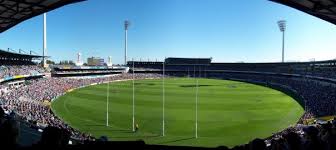Opinion: Football Aussie Style
Perspective on this sport from an Australian VOX Reporter
March 23, 2016
AFL is the abbreviation for Australian League Football.This is the world’s first version of football, and perhaps the hardest.
To possess the football, all you need to do is to pick it up, or catch it. Easier said than done! There are 18 players, per team, on the field, with four more on the bench waiting impatiently for someone to be tired enough to limp off; it is safe to say that nearly ten players from each side are fiercely contesting for the ball during most of the game. This often results in what you see below.
Both of the players knew they were going to collide, but one of the AFL’s essential rules which is engraved into every player is to keep your eyes on the ball. It is also said that the harder you go in, the less likely you are to be hurt. This last saying only applies to one of the two players.
Once you have the ball in your possession, you, naturally, decide what to do with it. You can’t throw it, as a throw is against the rules, nor can you just hold it, running or standing, as when you are tackled without trying to dispose of it correctly, the umpire will call holding the ball. Both errors result in a free kick for the opposition team.
How, then, do you dispose of it? You can do a handball. This is where you hold the ball in one open hand, and punch the ball with your other hand.
Is there another way to dispose of the ball? Well, the game is called football, after all. Kick it!
AFL has recorded kicks of up to, and over, 100 meters (equalling 110 yards). There are many different ways to kick an AFL football (Yes, we have our unique football shape). (#1) shows a normal kick, called a ‘drop punt.’ (#2) shows a bomb forward, where the player had too little time for a composed drop punt, and hacked it forward in panic. (#3) shows a barrel, or a torpedo.
This is a fan favorite, as this is the way to kick nearly 100 meters. (#4) is where the players show off their soccer skills, but this certain way of doing it is very rare. (#5) is called ‘along the ground,’ which is when a composed player chooses the ground to the air, and kicks the ball along the ground. (#6) is where the player finds himself in a tight angle and kicks a very special kind of kick, called a ‘checkside,’ or a ‘banana.’ (#5) and (#6) both take an extreme amount of skill to execute.
Once the ball is in the air, what happens next? Well, you could let it fall to the ground, but after seeing the bump shown above, most people would agree that if there were an easier option, they would take it. It so happens there is, but it too can result in some nasty collisions, as you have to get it before it touches the ground.
(#1) is a standard mark (catch), where there was no one near enough to prevent the player from taking the mark, and so he just caught it.
(#2) is where the player has his opposing man next to him and he has taken what is called a contested mark,’ but with a single hand.
(#3) is where, once again, there is only the one player from each team, going for the ball, but to foil the opposing player’s chances of touching the ball, the player has jumped on top of him to mark the ball.
(#4) is where there are many players around the ball, but a certain player decided that he would go a bit higher than the rest to stop the backmen’s punches at the ball, and catch the ball himself, at leisure (if you can call it that). This is one of the most exhilarating moments of AFL.
(#5) is one of the frequent times where many players are around the fall of the ball, leaving a very skilled few who can actually take the ball before anyone else touches it.
(#6) is where two or more players are travelling in opposite directions towards the fall of the ball. In this case, neither player would give way, but some of AFL’s lesser players would have stepped back from such a collision as this.
Why so much trouble for marking the ball? Well, the result is the same as a free kick. If the umpire deems that the player who touched it first held it for long enough, he blows the whistle to stop play, and the player who marked the ball can go back a few steps and kick it to wherever he wants, unopposed for a short amount of time. This is very handy when inside the forward line, as you may take a set shot for goal. When a player has marked the ball, his team rushes around the ground, trying to find enough space for another mark to be taken, preferably closer to goal. The opposing team, however, leaves one man ‘on the mark’ (the exact spot where the player who caught the ball landed) so that he can prevent the player from running forward.
The player who has the ball must be careful of the man on the mark, since if he gets too close when kicking, the player may touch the ball as it is rising in the air, at the least making it impossible to be marked, and at the best, knocking it ‘to ground.’ The man on the mark must also be careful, as the player with the ball has a protected zone, and if he steps forward, ‘off the mark,’ or another player from his team gets too near the player with the ball, a fifty-meter penalty is ensured. This means that the player with the ball has his mark advanced forward fifty meters by an umpire, and thus gains about a third of the ground.
Fifty-meter penalties are rare, but are also called when a player uses foul language, has made rough contact or has in any way been a bad sport. Once the player has taken the mark it takes only around 15 seconds for all that was described to unfold.
What sort of other penalties are there? Well, since AFL has no use for pads, umpires have outlawed tackles below the knee and above the shoulder, as concussion is a very common occurrence. If a player makes a tackle with one arm around the shoulder, or somehow hits another player on the head or neck, the offended player is awarded a free kick. What if a player ducks so that he gets taken in a ‘high-tackle?’
In recent years, several of AFL’s poorer sports have begun such a practice, but in midway 2015, the umpires ruled that anyone who ducked his head, with the ball in his possession, and tried to get caught in a high-tackle,’ was to be counted as holding the ball. It was ruled that since he had enough time for antics with his head, he also had enough time to dispose of the ball. Such is life, and people who duck their heads are not thought of kindly, and often receive boos from the crowd as a result. Another important rule is that when the ball has been kicked in the air and players are rushing towards it, you are not allowed to infringe the movement of any opposing player’s arms, hold his body back or stand still in the way of him and the ball.
This rule was implemented since it was decided that in AFL, players should worry more about the ball than about their opposing players. If any player was to commit any of the above prohibited actions behind or in front of where the play was taking place, he would be penalised with fifty meters from either where he committed the infringement or fifty meters forward of the ball, whichever would give more advantage to the team who was offended.
What methods do AFL players use to score? Well AFL’s way of scoring is unique. Take a look at the picture.

See how there are four posts? The outside posts are deemed out-of- bounds. If the ball touches these posts, or goes over the line at any part of the ground, it is a throw-in, where an umpire throws the ball back into play. However, if the ball has been kicked and is still untouched in the air when it hits the post or flies over the line, it is called out-on- the-full. If the umpire has made that call, the team who didn’t kick it gets a free kick from where the ball passed out of bounds or hit the post.
Look at the picture again; in view are three different places where the ball could pass through: one in the middle and one on each side. If the ball goes over the side-lines, regardless of whether it has been touched or grounded or is still lying, it scores a single point.
However, if the ball is kicked by the attacking team, and flies or bounces through the middle untouched, it is a goal, and six points are scored. If the ball is coming towards the goal, a defender will not hesitate to stop the play by allowing the other team to score a single point. Once a point is signalled, a chosen defender has a free kick in the goal square to bring the ball back into play. Teamwork is an essential factor into winning one of these AFL games. The competition is spread out all over Australia, with 18 teams in the league:
Adelaide Crows
Brisbane Lions
Carlton Blues
Collingwood Magpies
Essendon Bombers
Fremantle Dockers
Geelong Cats
Gold Coast Suns
Greater Western Sydney Giants
Hawthorn Hawks
Melbourne Demons
North Melbourne Kangaroos
Port Adelaide Power
Richmond Tigers
St. Kilda Saints
Sydney Swans
West Coast Eagles
Western Bulldogs
These 18 teams have 24 rounds, with two byes each, but they cannot, for even a moment, relax. In every game of AFL, any team is a chance at coming away with a win, no matter the weather or the ground location, and for the eight teams who finish closest to or on the top are set up in the finals.
Rd1: Qualifying finals: 1 v. 4 2 v. 3 (None of these teams are eliminated, but the winners have a week’s rest, while the losers will play again next week) Elimination finals: 5 v. 8 6 v. 7 (The two losers of these games are eliminated, while the winners advance to play the losers of the qualifying finals)
Rd2: (Now, for the sake of example, presume 4 & 2 and 8 & 6 lost) Semi finals: 4 v. 7 2 v. 5 (The losers are once again eliminated, while the winners go on to play 1 & 3)
Rd3: (Now, for the sake of example, presume 7 & 2 lost) Preliminary finals: 1 v. 5 3 v. 4 (As with the last two rounds, losers are eliminated, and the two teams who won proceed to the Grand Final)
Rd4: (Now, for the sake of example, presume 5 & 4 lost)
Grand Final: 1 v. 3 Now that the big day is here, the city of Melbourne, where the Grand Final is always held, is at its busiest time of the year, and if a team from the outside of Melbourne (there are only 8) made it, then even more so. Marches are held, extra trains run in from the outer suburbs, and it is just about the country’s favorite day. The two teams will face each other off in front of 100,000 fans, and the best player on the winning team will be awarded the Normsmith Medal, for best on ground. Neither team will come off having done less than their best.
What sort of players are there in AFL? Although every player has a defined position for their game day, and instructions concerning where on the oval they are supposed to be found, the independent decisions of individual players are something that is recognized as one of AFL’s most attractive attributes. An individual player needs a 100% mental focus, the ability to run at their fastest speed for 7-8 minutes without slowing down and execute their skills flawlessly while under fatigue. The way the field is set out is with three backmen, three half-backmen, three centers (one in the center circle and the other two are on each wing), three half-forwards, three forwards, one ruckman, and two players who continually chase the ball.
The three backmen must be of considerable size (185 centimeters minimum) and their particular strengths are used to prevent the opposing forwards from taking a mark and keeping the other team from scoring. An especially hard task is given to the fullback, who resides in the middle of the backline. He must stay side by side with the opposing fullforward, which is hard because these men can be of heights up to 211 cm, with specially trained abilities to kick goals and mark the ball under any circumstances. A fullback must be of considerable size and body strength to compete with him.
The three half-backmen do not have to worry about their size as much as the back three, as they see more of the ball than their opponents. Although they still need to keep an eye on their opponent, the half-backs are to rebound the ball after a failed attack forward. They are the ones who are expected to pick up the ball when the opposing team has gone forward, but success has been prevented. It is advised, however, that the center-half- back be of a similar size to the fast-running center-half- forward on the opposing team, as he can often take a similar play style to the fullforward.
The centers are undoubtedly the hardest-working players of AFL. They must run flat out for nearly ten minutes, gathering, marking or spoiling the ball whenever needed. Where the ball is, there must be the players who are ‘on-ball.’ The two wingers have a similar role, but they are recommended to stick to their half of the ground. These five players must have the ability to do anything and everything.
The half-forwards must run towards the ball, but, until it is in the forward line, they must stay in front of it. They are to provide a target forward of the ball, and should be proficient in marking and goal kicking. The full forwards are to kick lots of goals. They must stay around the goals, but, like in basketball, they need to create space for each other. Their goal-kicking skills are such that physics are nearly defied (see below). Also, one is often needed to play ruck (explained below) when the main ruckman takes a rest.
The ruckman is a single player of massive size. He has one main role, but as the game has progressed throughout the years, so have coaches tried to make their ruckmen more useful. He is for the start of the game when the siren has sounded and the umpire has bounced the ball in the center circle. The ball will fly up in the air from the impact of the bounce and, as it falls, the two opposing ruckmen will leap up at it and attempt to tap or punch it down to one of their centers, who will then try to kick the ball forward.
Then, if a player is tackled and no one can gain possession, the umpire blows the whistle, looks around for any offences, and if there are none, he then throws the ball up in the air for the ruckmen to tap. If the ball has gone over the line and is not out on the full, the umpire will decide whether or not a player guided it out intentionally. If so, the opposing team will get a free kick, but if not so, a boundary umpire will throw the ball high, about twenty meters back, to allow the ruckmen to tap it down.
These players are crucial for clearances and their team’s momentum. That makes 18, and four more on the bench makes 22. These four spares can be any category of player wanted by the coach, but they are often composed of an on-baller, a center-half- forward, a center-halfback and sometimes a second ruckman.
Although AFL was the first played sport that may be called football, the world has not had as avid an interest in it as it has in soccer, or even NFL. Yet in most countries, there will be some people who know of this game, and are in awe of it. It has a certain thrill that no one who has seen it in full can deny, and this has made it quickly rise above soccer, gridiron, basketball, cricket and all other sports in Australia. Yes, AFL is Australia’s #1, and every Australian is proud that this is so.





